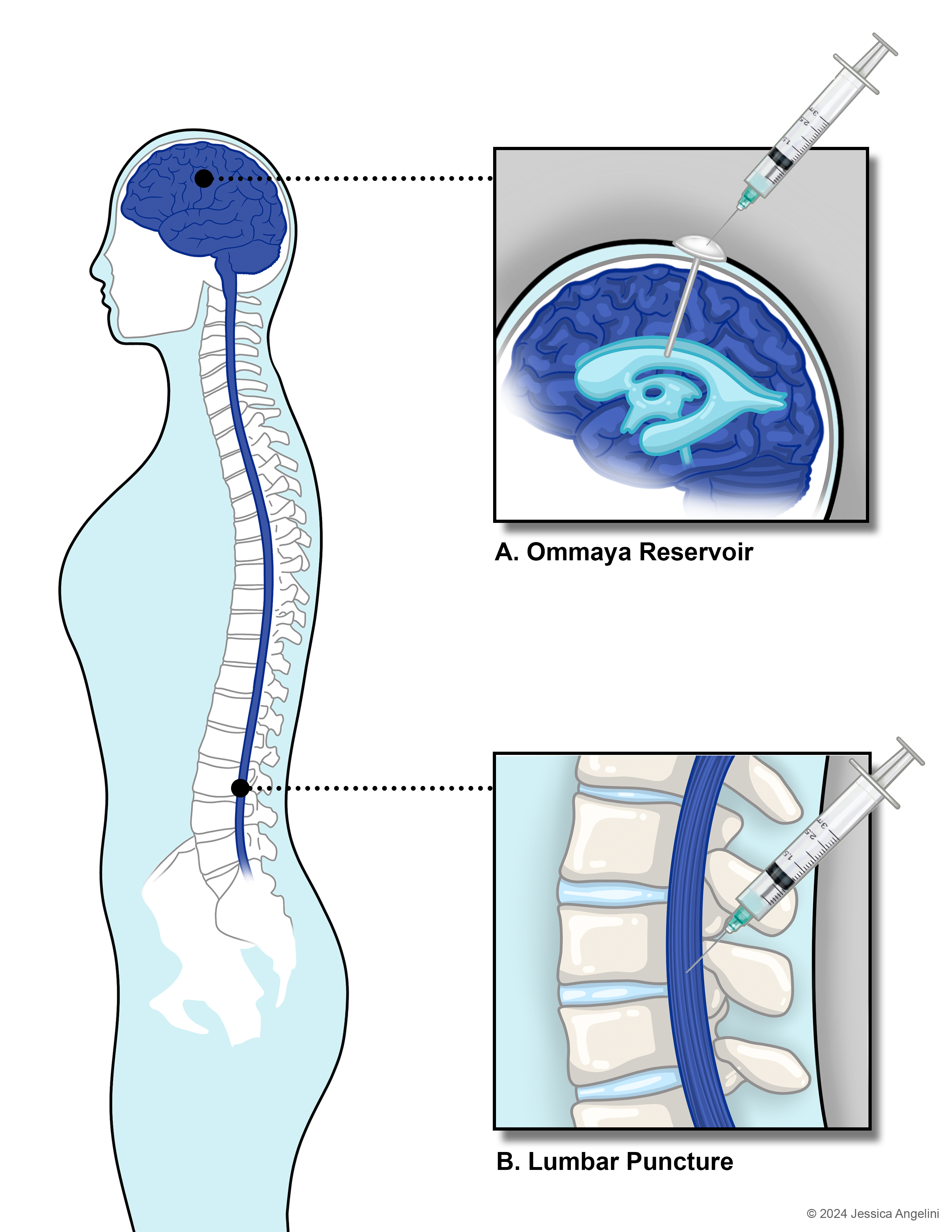Intrathecal Chemotherapy (IT Chemo)
What is the cerebrospinal space?
The cerebrospinal space is the area around the spine and brain that holds cerebrospinal fluid (CSF). CSF is a colorless fluid made in the brain. It acts as a buffer around the brain and spinal cord to keep them safe from injury.
What is intrathecal chemotherapy?
Intrathecal (IT) chemotherapy is when chemotherapy is given directly into the CSF. It is used to prevent or treat cancers that are in the CSF. When a cancer is in the CSF, it may be called CNS (central nervous system) involvement. Chemotherapy given intravenously (through the veins) and/or by mouth is not often able to cross into the CSF, so it is unable to treat these cancer cells. Giving chemotherapy directly into the CSF allows the medication to reach the cancer cells.
IT chemotherapy may be given as part of your chemotherapy regimen or on an as-needed basis. IT chemotherapy may be added to your treatment plan if cancer cells are found in your CSF.
Intrathecal chemotherapy can be given during a lumbar puncture or through an ommaya reservoir (shunt). Before having IT chemotherapy, you will have lab work done to check your blood counts. Your platelets will need to be checked to ensure that your blood will clot at the site after the procedure. Your provider will also talk to you about medications that you take or allergies you have that could affect the procedure.
How is IT chemotherapy given through a lumbar puncture (LP)?
A lumbar puncture is a procedure where a needle is placed between two bones (vertebrae) in your spine. The needle may be used to withdraw (remove) CSF and/or to give the chemotherapy directly into your CSF. It can be an uncomfortable procedure, but you should not feel pain. A lumbar puncture can cause some anxiety and some patients need an anti-anxiety medication before the procedure. You will want to go to the bathroom before the procedure because you will not be able to move during the LP.
- For the procedure, you’ll need to be positioned in a way that creates space between the bones in the back. Opening this space makes it easier for the provider to put the needle in the right spot. You will likely either lie on your side in a fetal position or you will sit on the edge of your bed and rest your chest, arms, and head on a tray or chair that has been placed in front of you with your feet dangling off the bed.
- Once you are in a comfortable position, your provider will feel your back to find the best place to insert the lumbar puncture needle. It is important to remain still during this time unless you are told to move. Once your provider has figured out where to insert the needle, they will mark the spot on your skin with either a marker, a pen, or a piece of plastic.
- Your provider will put on sterile gloves. The area is cleaned before the procedure. You will have a drape placed on your back to cover the area not being affected by the lumbar puncture.
- Your provider will use a needle to give some anesthetic (numbing) medication in the area where the lumbar puncture is being done. You may feel a pinch and some burning or pressure for a few seconds before the numbing occurs. Your provider will touch the area and ask if you can feel it to ensure there is enough numbness.
- Next, a long, thin needle will be used to enter the spot that was marked and numbed. You may feel pressure but you should not feel pain. It is important for you to stay as still as possible. If you need to move or are feeling pain let your provider know. Once the needle is in the space, CSF is collected into test tubes. Your chemotherapy is then given through this needle directly into the CSF. The whole procedure takes about 30 minutes.
- Once the procedure is done, the needle is removed and either gauze and tape or another type of dressing is placed over the area. You will then be told to lie flat for 30-60 minutes.
How is IT chemotherapy given using an ommaya reservoir?
An ommaya reservoir (shunt) is a port that is placed under the skin on your head. The reservoir has a tube attached to it that ends in a ventricle of the brain. Ventricles are where CSF is made. It may be placed if you need IT chemotherapy often. It can also be used to remove CSF for testing.
The steps to give IT chemotherapy through an ommaya reservoir are:
- The provider puts on gloves and the skin on top of and around the ommaya reservoir is cleaned.
- A needle is used to access the ommaya port by inserting it through the skin and into the port.
- Chemotherapy can be given directly into the reservoir, which flows into the CSF. If CSF is needed for testing, the needle can be used to remove CSF.
- A dressing or band-aid is put where the needle was removed.
How can you care for yourself after IT chemotherapy is given?
If CSF was removed your body will have to make more CSF to refill the space. When you have less CSF than normal, you may get a headache. Lying flat for 30 to 60 minutes after the procedure can prevent a headache. If you have a headache after the procedure, let your provider or nurse know. If you have side effects like dizziness, bleeding from the needle insertion site that won’t stop, blurry vision, uncontrolled nausea and vomiting, or confusion, it is important to let your provider know right away.
If you have any questions or concerns, please talk to your provider.
